We Are the Land
We find the experience of our ancestors in:
|
the furs traded to Europeans for guns;
|

Inuit woman with Naskapi snowshoes and hunting costume,
carrying rifle, 1921-1922, photograph by Frederick W. Waugh
Canadian Museum of Civilization, 54654
|
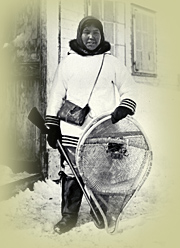
|
|
the gun case made of dressed buckskin;
Gun Case
Gwich'in (Kutchin)
Northwest Territories
About 1888-1892
Animal hide, wool yarn, porcupine quills, cloth, thread and sinew
Canadian Museum of Civilization, VI-I-78, CD95-074-058
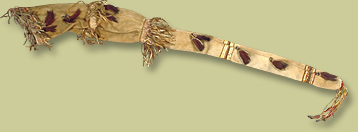
|
|
the baskets made for sale to settlers;
|

Basket
Mi'kmaq (Micmac)
Before 1911
Ash splints and sweet grass
Canadian Museum of Civilization, III-F-70 a,b,
CD97-142-023
|
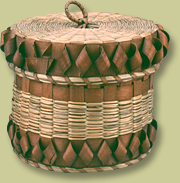
|
|
the harpoons and spears used to hunt Arctic seals;
|

(top) Harpoon
Netsilingmiut (Netsilik Inuit)
Nunavut
Before 1959
Bone or antler, animal hide and sinew
Canadian Museum of Civilization, IV-C-3348 a-d
|

(bottom) Spear
Nunavimiut (Quebec Inuit)
Quebec
Before 1958
Wood, bone, metal, animal hide and sinew
Canadian Museum of Civilization, IV-B-697
|


|
|
the spoon made of mountain goat horn, steamed
into shape and carved with the emblems of a family's history;
Feast Spoon
Haida
British Columbia
Before 1900
Mountain sheep horn and abalone shell
Canadian Museum of Civilization, VII-B-1509,
CD94-618-024
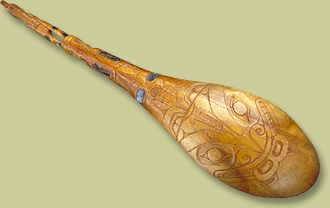
|
|
the hat made of woolen cloth and the hat made
of dressed skins and feathers;
|

Hood
West Main Cree (Swampy Cree)
Probably 1840-1865
Wool, ribbon, glass beads, silk embroidery thread, caribou skin,
cotton thread and sinew
Canadian Museum of Civilization, III-D-606, CD95-074-097
|
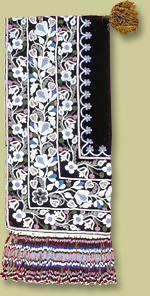
|
|
the hat, woven of spruce root into a fine,
waterproof fabric;
Hat
Haida
British Columbia
Before 1884
Spruce root
Canadian Museum of Civilization, VII-B-890,
CD96-006-030

|
|
the packsaddle decorated with beadwork;
Saddle
Anishnaabe (Plains Ojibwa / Saulteaux)
Late 1800s
Animal hide, glass beads, wool and cotton
Canadian Museum of Civilization, V-F-164
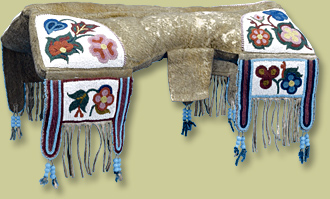
|
|
the canoe made of birch bark;
Canoe
Atikamekw
Quebec
About 1900
Birchbark
Canadian Museum of Civilization, III-L-228,
CD96-129-031
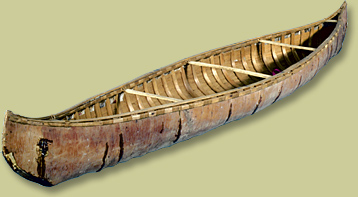
|
|
the corn (maize) raised by Aboriginal farmers
for thousands of years, the wild rice harvested from the shallows
of lakes, the maple syrup processed for centuries before it met
pancakes.
|

Braids of corn at Emily Generals' home on the Grand River
Iroquois Reserve at Grand River, Ontario, 1949,
photograph by Marius Barbeau
Canadian Museum of Civilization, J3003,
CD96-1179-001
|
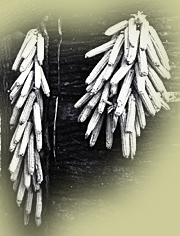
|
The first European visitors survived with our ancestors'
knowledge, experience and help.
In 1535-36 men traveling with the French explorer, Jacques
Cartier, were treated for scurvy by Aboriginal people living
near present-day Montreal.
Cartier wrote,
"...after drinking [Annedda - a tea made from the bark
and/or needles of coniferous trees] two or three times, they
recovered health and strength and were cured of all the diseases
they had ever had."
Our lives have always depended on our understanding of the land,
of what it had to give, and of what we were obliged to give to
it. It would be impossible for us to recount our histories
without telling about the land.
Many of us still depend on the land for our livelihood. Even
those who live and work in cities often return to hunt or dry
fish. In this way, venison and moose meat, dried and canned
fish, seaweed and dried Saskatoon berries, find their way to
city kitchens.
We speak of our knowledge of the land in 53 languages, plus
English and French. Fifty of these languages are spoken now by
very few people. If these languages die, they will take with
them the words that express precisely the foundations of our
knowledge and our relationship with the land.